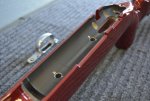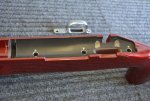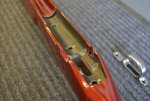My thoughts/experience. This comes after splitting a few hairs over this stuff. If my goal is to do the best job I can, then I have to start looking at little things. That is where this discussion is born from.
First, we define exactly what a pillar is supposed to be doing. In the "old days" stocks were predominantly made of wood. Because wood is an organic material it is responsive to big swings in ambient weather. The purpose of the pillar was to help mitigate some of this reality. Guard screws had the annoying tendency to work themselves loose as the wood swelled/shrank in response to humidity changes. By adding a pillar to the assembly, the growth/shrinkage largely becomes irrelevant because the physical distance from the screw head to threads on the action doesn't change.
The detail on whether or not the pillar head should have a radius (for me anyway) is an easy answer. I am of the opinion they should be and multiply this opinion by 1000x if the pillars are aluminum. AL is great because it basically doesn't rust. The consequence with this however is that the skin layer of Aluminum Oxide that forms to prevent additional corrosion creates a barrier that epoxy struggles to bond to well. What I have seen over time is that the edges of the resin start to erode away from the guard screw holes. That's part 1 of this.
Part two is the resin itself. Any resin system worth a shit has a few common characteristics. It needs to have a very high percentage of solids present, have good shore hardness when cured, a low percentage of shrinkage, be tolerant of acids/alkali chemical exposure, and offer a long working clamp time so that the person doing the work isn't rushed. The high percentage of solids is a big deal. Think of it as concrete. If your sidewalk is cement only, it's not going to last. The solids act as the aggregate that binds the glue. Resins are no different. So, long story short, when you have a flat pillar the resin becomes extremely thin right at the tangent point of the receiver. This is where/why the bond starts to fail over time. Increasing the thickness is how you avoid this annoyance. A radius pillar solves it by effectively sealing itself from the glue. X2 if you take the time to prep the job so that you attach the pillars to the action prior to bedding the gun.
Taking all this in leads one to think there's the potential for a problem because it starts to suggest every pillar commonly made today is done incorrectly. I agree with this and it's why I started making my own. The rib supports the load. The resin fills the void around it and because it's .05" thick, you have room for all the solids in the resin system to be present. The pillar is stainless steel. Food and beverage grade to be exact and this is because it's almost completely void of any iron. A big deal if you're exposing your stuff to salt spray common to any maritime environment.
View attachment 7458049
Now, as for pillars contacting in a V block setup:
Think about whats going on. You have a channel that your bridging with a cylindrical object. That object has a thin wall. Clamping it to the channel is handled by a pair (trio in some cases) of screws. The screws will exert a great deal of "pulling" (tensile) action on this thin walled cylinder. IF a gap is present by design between the cylinder and the pillar, its not impossible to distort the cylinder or the V shaped channel. Because of this, 3 points of contact are beneficial.
Anyways, that's my thoughts/opinion on the matter. Hope it helps.
C.





